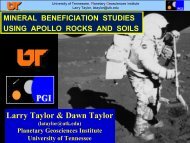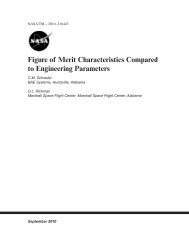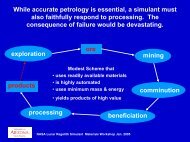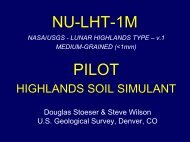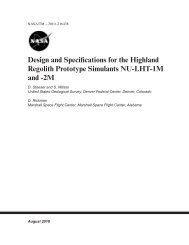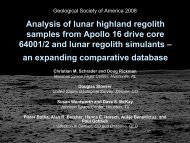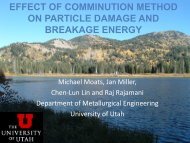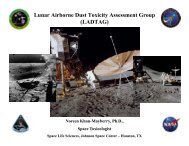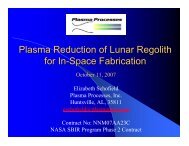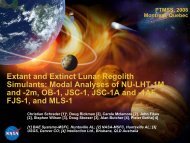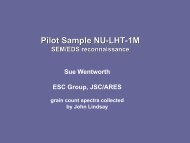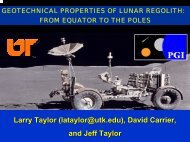Book of Abstracts- Lunar Regolith Simulant Materials Workshop
Book of Abstracts- Lunar Regolith Simulant Materials Workshop
Book of Abstracts- Lunar Regolith Simulant Materials Workshop
Create successful ePaper yourself
Turn your PDF publications into a flip-book with our unique Google optimized e-Paper software.
THE STATUS OF LUNAR SIMULANT MATERIALS, WORKSHOP OVERVIEW AND OBJECTIVES.<br />
L. Sibille, BAE Systems Analytical and Ordnance Solutions, NASA Marshall Space Flight Center, XD42, Huntsville,<br />
AL, 35812, Laurent.Sibille@msfc.nasa.gov.<br />
Introduction: As NASA turns its exploration ambitions<br />
towards the Moon once again, the research and<br />
development <strong>of</strong> new technologies for lunar operations<br />
face the challenge <strong>of</strong> meeting the milestones <strong>of</strong> a fastpace<br />
schedule, reminiscent <strong>of</strong> the 1960’s Apollo program.<br />
While the lunar samples returned by the Apollo<br />
and Luna missions have revealed much about the<br />
Moon, these priceless materials exist in too scarce<br />
quantities to be used for technology development and<br />
testing. The need for mineral materials chosen to<br />
simulate the characteristics <strong>of</strong> lunar regoliths is a<br />
pressing issue that must be addressed today through<br />
the collaboration <strong>of</strong> scientists, engineers and program<br />
managers. The workshop on <strong>Lunar</strong> <strong>Regolith</strong> <strong>Simulant</strong><br />
<strong>Materials</strong> being held this week brings together experts<br />
from a wide range <strong>of</strong> disciplines to define the nature <strong>of</strong><br />
the simulants needed and <strong>of</strong>fers guidelines for the sustainable<br />
availability <strong>of</strong> these reference materials.<br />
Present Status <strong>of</strong> <strong>Lunar</strong> <strong>Simulant</strong> <strong>Materials</strong>:<br />
No coordinated program currently exists in the U.S.A.<br />
to define reference materials to be used as analogs <strong>of</strong><br />
lunar materials. Such coordinated efforts have existed<br />
at different times in the past to either provide these<br />
materials to specific technology development programs<br />
such as the Apollo Landing Module and <strong>Lunar</strong><br />
Rover or when NASA policies showed a renewed interest<br />
in lunar missions as was the case in 1989 and the<br />
early 1990’s. While no Apollo lunar simulants remain<br />
today, the more recent efforts led to the development<br />
and distribution <strong>of</strong> materials such as MLS-1 [1], a titanium-rich<br />
basalt from Minnesota and JSC-1 [2], a<br />
glass-rich basaltic ash from the volcanic fields <strong>of</strong> the<br />
San Francisco mountains <strong>of</strong> Arizona. Both <strong>of</strong> these<br />
simulant materials were successful in the sense that<br />
they provided known source materials for researchers<br />
and engineers but were only adequate for certain applications.<br />
These deficiencies led to efforts to ameliorate<br />
their characteristics, particularly to better duplicate<br />
the content <strong>of</strong> glassy agglutinates in lunar regoliths<br />
(MLS-2). The lack <strong>of</strong> funding and the waning interest<br />
from NASA in the 1990’s resulted in disappearing<br />
stocks and the resurgence <strong>of</strong> a variety <strong>of</strong> ‘home-made’<br />
lunar simulants and independent commercial materials.<br />
Today, neither <strong>of</strong> the simulants mentioned above are<br />
available from their manufacturers. In parallel to<br />
NASA-funded simulants, the Japanese space agency<br />
NASDA, which is now the Japan Aerospace Exploration<br />
Agency, has funded a development program for<br />
lunar simulant materials for the past decade. As a result,<br />
simulants such as FJS-1, MKS-1 are used in Japan,<br />
but are not well known or used in the USA [3].<br />
These materials have been characterized extensively in<br />
terms <strong>of</strong> bulk chemical composition, mineralogy, geotechnical<br />
properties and are available in modest quantities.<br />
The chaotic situation concerning lunar simulant<br />
materials calls for a focused and coordinated development<br />
<strong>of</strong> large quantities <strong>of</strong> simulant materials in the<br />
near future to meet the needs <strong>of</strong> present and future<br />
efforts to develop technologies and test new hardwares<br />
for lunar precursor missions and lunar base development.<br />
<strong>Workshop</strong> Overview and Objectives: Building<br />
from the results and conclusions <strong>of</strong> the 1989 <strong>Workshop</strong><br />
on Production and Uses <strong>of</strong> Simulated <strong>Lunar</strong> <strong>Materials</strong><br />
[4], we have adopted the following two main<br />
objectives for this workshop; 1) To obtain a consensus<br />
from expert participants on the requirements for the<br />
definition, production, validation and distribution <strong>of</strong><br />
<strong>Lunar</strong> <strong>Regolith</strong> <strong>Simulant</strong> <strong>Materials</strong> based on the needs<br />
<strong>of</strong> technology developers and the knowledge <strong>of</strong> lunar<br />
mineral resources and their environment, and 2) To<br />
propose strategies to the Exploration Systems Mission<br />
Directorate to assure that all R&TD programs for lunar<br />
surface systems adopt the same lunar simulant reference<br />
materials.<br />
After a day <strong>of</strong> presentations on how the various<br />
characteristics <strong>of</strong> the lunar regolith affect a wide range<br />
<strong>of</strong> lunar operations from landing a spacecraft to extracting<br />
resources and affecting human health, the participants<br />
will be asked to work in separate groups to<br />
examine the applicability and importance <strong>of</strong> specific<br />
properties <strong>of</strong> the lunar materials that must be duplicated<br />
in simulant materials. This initial session will<br />
be followed by the definition <strong>of</strong> requirements to specify<br />
the level <strong>of</strong> accuracy with which these properties<br />
should be duplicated. The scientific organizing committee<br />
will then guide the discussion to identify a family<br />
<strong>of</strong> potential simulant materials. Finally, the participants<br />
will be asked to examine the critical issues <strong>of</strong><br />
production feasibility, quality control, storage and distribution,<br />
and prioritization <strong>of</strong> these materials based on<br />
spiral development <strong>of</strong> the exploration capabilities.<br />
References: [1] Weiblen P.W., Murawa M.J., and<br />
Reid K.J. (1990) “Preparation <strong>of</strong> simulants for lunar<br />
surface materials” Engineering, Construction and Operations<br />
in Space II, ASCE, 428-435; ; [2] D.S.<br />
McKay, J.L. Carter, W.W. Boles, C.C. Allen & J.H.<br />
Allton (1997) “JSC-1: A new <strong>Lunar</strong> <strong>Regolith</strong> Simu-<br />
1



